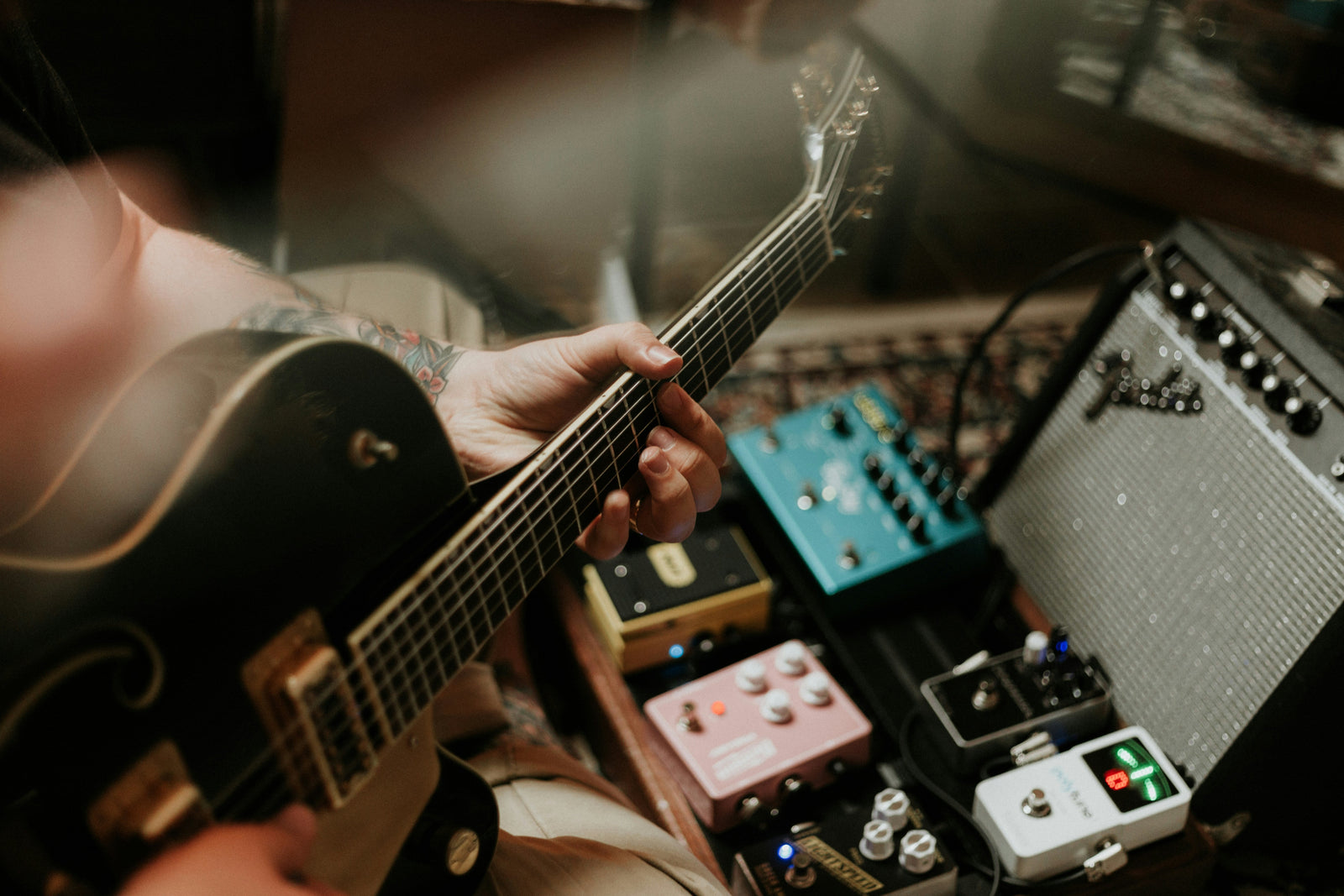Guitar Tuner Handheld Overview
A handheld guitar tuner is a musician's best friend. It ensures that every note played is pitch-perfect. These compact devices are essential for anyone playing a stringed instrument. They work by picking up sound frequencies to determine if your guitar is in tune.
Unlike pedal tuners or apps, handheld models are easy to use and quick to respond to. They're perfect for beginners and professionals alike, fitting into a gig bag. Owning a reliable tuner is a step toward more accurate and enjoyable performances.
How Does a Guitar Tuner Handheld Work?
A guitar tuner handheld is a vital tool for musicians aiming to achieve perfect pitch. This device uses either a microphone or a vibration sensor to detect the pitch.
The most common type is the clip-on tuner, which attaches straight to the instrument. It picks up direct vibrations from the guitar, bypassing ambient noise. This feature makes it very effective in noisy environments like live venues.
The tuner then processes the signal to determine if the note is sharp, flat, or in tune. The tuner displays the results on a small screen, usually as a needle dial or an LED readout. For precise tuning, the screen may turn green when the note is in tune. Advanced tuners offer different tuning modes, including chromatic scales and alternate tunings.
Technology Behind Pitch Detection
Understanding pitch detection technology in handheld tuners is essential. It optimizes their use. Most handheld tuners use either piezoelectric sensors or built-in microphones.
Piezoelectric sensors detect vibrations through physical contact with the instrument. Making them less susceptible to ambient noise. Microphones pick up sound waves in the air, which surrounding sounds can influence. This makes them more versatile but less accurate in noisy environments.
Advantages of Using a Guitar Tuner Handheld
The advantages of using a guitar tuner handheld are many. Especially for musicians who value efficiency and portability.
Portability and Convenience
These tuners are small and lightweight, making them easy to carry in a pocket or instrument case. This portability ensures you can tune your instrument anywhere. Whether backstage or at a campfire jam session.
Ease of Use
Handheld tuners are very easy to tweak. It features simple interfaces that even beginner musicians can navigate with ease.
They offer quick tuning, allowing you to spend more time playing and less time setting up. This is particularly beneficial during live performances when time is of the essence.
Accuracy in Noisy Environments
One significant advantage of handheld tuners is their accuracy. They provide precise tuning in various environments, thanks to advanced digital technology.
App tuners rely on a smartphone's microphone. Handheld tuners often use clip-on sensors that detect instrument direct vibrations. This makes them far more reliable in noisy settings. Settings where ambient sounds could interfere with tuning accuracy.
Versatility and Added Features
Additionally, many handheld tuners come with extra features that enhance their utility. For example, some models include metronomes, tone generators, and many tuning modes.
Durability
Another benefit is the durability of handheld tuners. Their design allows them to withstand the rigors of travel and frequent use. This makes them a long-lasting investment for serious musicians.
Their resilience makes them a constant companion throughout a musician's career.
Types and Models of Guitar Tuner Handheld Available
When exploring the various types and models of guitar tuner handheld devices. Musicians can find a range to suit any need. Handheld tuners generally fall into two main categories: digital and analog.
Each type comes with distinct features that cater to different preferences and requirements.
Types of Guitar Tuner Handheld
Digital Tuners
Musicians favor these tuners for their precision and extra features. They usually have a clear digital display. Many include functions like metronomes or support for many instruments.
Analog Tuners
These feature a traditional physical needle to display pitch. Analog tuners are simpler and don't rely on batteries. It is appealing to those who value straightforward technology.
Among digital tuners, several variations cater to specific needs:
- Clip-on Tuners: These tuners attach to the instrument and tune based on vibrations. This makes them ideal for noisy environments where ambient sound may disrupt tuning.
- Pedal Tuners:These are often used by electric guitarists. They fit into a pedalboard and allow hands-free tuning during performances. They are robust and integrate with other gear.
- Soundhole Tuners: Designed for acoustic guitars, these tuners fit inside the soundhole. They are discreet and convenient, always attached, and ready for use.
Each type of tuner offers unique benefits, so consider your specific needs. Whether you perform in noisy settings or need various tuning capabilities. There's a handheld tuner for you.
Guitar Tuner Handheld Brand: KORG
KORG is a well-respected brand known for its wide range of music gear. This includes some of the best handheld tuners available. Musicians praise their tuners for reliability and precision, making them a top choice. KORG's handheld tuners offer clear displays and responsive controls for accurate tuning.
KORG's commitment to quality and innovation is evident in its line of handheld tuners. They offer features that cater to the practical needs of today’s musicians. It combines technology with simplicity for optimal tuning every time.
KORG Guitar Tuner Handheld
Top KORG Guitar Tuner Handheld for Beginner: CA-50
The KORG CA-50 is a top choice for beginners looking for an effective guitar tuner handheld. It balances precision tuning with ease of use.
Here's a quick overview of the CA-50:
- Compact and easy to carry, ideal for tuning on the go.
- Features an enhanced LCD screen for clear pitch and note display.
- Supports a wide tuning range from A0 (27.50 Hz) to C8 (4186.01 Hz).
Key features include:
- Built-in microphone for accurate note detection without extra equipment.
- Visual markers for major and minor thirds help achieve perfect harmonies.
- "Sound Out" mode provides a reference tone, useful for tuning by ear.
The CA-50 also boasts a long battery life, up to 135 hours. It has a low battery indicator to prompt timely replacement. These functionalities make it not only a tuning tool but also an aid for musical training.
Top KORG Guitar Tuner Handheld for Professionals: OT-120
The KORG OT-120 stands out as a chromatic tuner designed for professional musicians.
Here's a brief look at its key features:
- The OT-120’s vertical layout is easy to hold, enhancing operability for professional use.
- Features a dual-display system. It includes a needle-type indicator and a backlit LCD for comprehensive tuning information.
- Equipped with a large dial for mode selection. It also has easy-to-use buttons for smooth operation.
Performance capabilities include:
- Precision Tuning: Utilizes a high-precision needle-type meter for accurate pitch discrepancy signs.
- Flexible Tuning Modes: Offers Auto mode for automatic note detection and Manual mode for specific tuning.
- Sound Production: Capable of emitting reference tones from C2 to C7. It has adjustable output levels for clear audibility.
These features make the OT-120 a top choice for professionals. Those who seek reliable and precise tuning in various musical environments.
Key Features to Look for When Choosing a Guitar Tuner Handheld
1. Tuning Accuracy
The most crucial aspect is how on point the tuner can detect and display the correct pitch. Look for tuners that offer precision within ±1 cents for the best results.
2. Display Type
A clear and readable display is essential, especially in varied lighting conditions. Musicians prefer LED or LCD screens with backlighting. They offer better visibility on dark stages or bright outdoor settings.
3. Response Time
The tuner should react on the spot to sound changes. A fast response time means less waiting and more playing.
4. Tuning Modes
Some tuners come with many tuning modes. This includes chromatic, guitar, bass, and sometimes even ukulele or violin settings. This versatility is helpful if you play many instruments.
5. Built-in Microphone vs. Vibration Sensor
Decide if you prefer a tuner with a built-in microphone or one using vibration sensors. Microphone tuners offer versatility but ambient noise can affect them. Vibration sensors provide more stability in noisy environments.
6. Battery Life
Since handheld tuners are portable, long battery life is important. Consider models with auto-power-off features to conserve battery life.
7. Size and Portability
The tuner should be compact and lightweight for easy transport in a gig bag or case. Its design shouldn't be cumbersome or interfere with your playing.
8. Extra Features
Some tuners also feature tools like a metronome, pitch calibration, or tone generator. These can be valuable for practice sessions.
9. Durability
A robust construction is key, as tuners often undergo frequent handling. Durable materials and a solid build protect against drops and damage.
10. Price
Finally, balance all the above features with your budget. There are options available at various price points. Ensure you do not compromise essential features for the cost.
Best Practices and Tips for Using Guitar Tuner Handheld
For optimal results from your handheld tuner, follow these tips and maintenance advice. Embrace the best practices for efficient tuning.
Tips for Effective Use
- Familiarize yourself with the tuner's display and features for quick adjustments.
- Regularly use the tuner to develop a better ear for correct pitches.
- For electric guitars, mute other strings while tuning one to prevent false readings.
- Set the tuner to the correct mode for your instrument if it has many options.
Maintenance and Care
- Battery Management: Always turn off the tuner when not in use to preserve battery life. Consider rechargeable batteries for cost-efficiency.
- Physical Care: Keep the tuner in a protective case or bag. These are to avoid physical damage and exposure to dust and moisture.
- Software Updates:For digital tuners, keep the software updated if the manufacturer provides updates.
General Best Practices
- Check Calibration: Regularly check and recalibrate your tuner to ensure continued accuracy over time.
- Learn Features:Familiarize yourself with all the features your tuner offers. Such as different modes or extra tools like a metronome.
- Practice Tuning: Regularly practice tuning by ear alongside using your tuner to develop auditory skills.
Ensuring Long-Term Reliability
- Update the firmware if available to improve functionality and accuracy.
- Inspect clip-on tuners for signs of wear, especially around the clip and joints.
Guitar Tuner Handheld Conclusion
Choosing the right guitar tuner handheld enhances your musical experience with accurate tuning. The key is finding a device that suits your specific needs, whether for quiet practice or noisy gigs.
Handheld tuners, like those from KORG, are reliable, accurate, and easy to use. It is suitable for both beginners and pros. Investing in a quality guitar tuner handheld like KORG's ensures precise tuning effortlessly. This ensures you can concentrate more on playing your music at its best.





